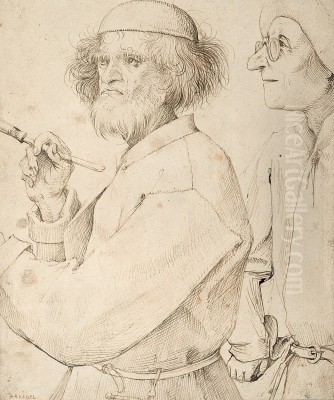
Pieter Bruegel the Elder stands as one of the most significant and innovative artists of the Northern Renaissance. Active during a period of profound social, religious, and political change in the Low Countries, Bruegel developed a unique artistic vision that combined traditional Flemish detail with new approaches to landscape and genre painting. His work offers an unparalleled window into the life and worldview of the 16th century, capturing both the rustic energy of peasant life and the sublime power of nature, often infused with moral commentary and keen observation of human folly. His influence on subsequent generations of artists in the Netherlands and beyond remains undeniable.
It is worth noting that the artist himself adjusted the spelling of his name during his career. Until 1559, he often signed his works as "Brueghel," but thereafter adopted the spelling "Bruegel," which is now most commonly used to refer to him, distinguishing him from his artistic sons who retained the "h".
Early Life and Uncertain Beginnings
The precise details of Pieter Bruegel's birth remain shrouded in some mystery, a common challenge when studying figures from this era. Art historians generally place his birthdate between 1525 and 1530. Even his place of birth is debated; traditionally, it was thought to be the village of Bregel near Bree in Limburg (present-day Belgium), which would explain his name. However, contemporary accounts, including that of early biographer Karel van Mander, suggest he might have been born in or near Breda, a significant town in North Brabant (present-day Netherlands). Regardless of the exact location, his origins likely lay outside the major artistic centers.
What is more certain is his artistic training. Bruegel moved to Antwerp, the bustling economic and cultural heart of the Low Countries at the time. There, he entered the workshop of Pieter Coecke van Aelst around 1545. Coecke was a highly respected and versatile artist – a painter, sculptor, architect, and designer of tapestries and stained glass – who had traveled extensively, including to Italy and Constantinople. He was known for his sophisticated, somewhat Italianate style. Bruegel's apprenticeship under Coecke would have exposed him to Renaissance ideals and diverse artistic practices.
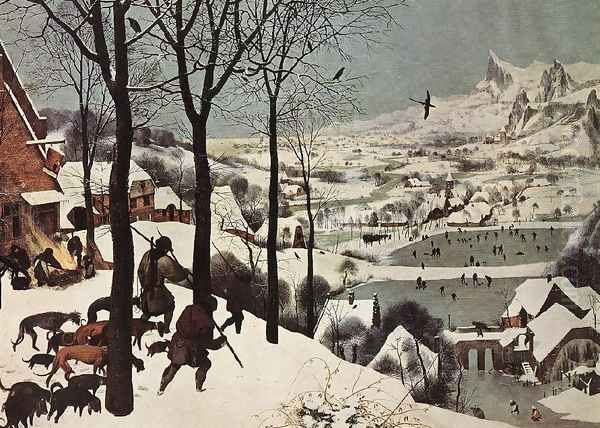
Further adding to his formative influences may have been Mayken Verhulst, Pieter Coecke's second wife and a talented painter and miniaturist in her own right. Some sources suggest Bruegel also received instruction from her. Later, Bruegel would marry Mayken Coecke, the daughter of Pieter Coecke van Aelst and Mayken Verhulst, forging a strong familial link to his master's household. By 1551, Bruegel had completed his training and was accepted as a free master painter into the prestigious Guild of Saint Luke in Antwerp, marking the official start of his independent career.
The Italian Journey and Early Career
Shortly after becoming a master, Bruegel embarked on an extended journey, a common practice for ambitious Northern European artists seeking to broaden their horizons and study the celebrated art of the South. Between roughly 1552 and 1554/1555, he traveled through France and, significantly, across the Alps into Italy. Evidence suggests he visited Rome, where he may have encountered the miniaturist Giulio Clovio, with whom he reportedly collaborated on some works. He likely also traveled further south, possibly reaching Naples and Sicily, as suggested by some of his later drawings and paintings featuring specific Italianate landscapes and seascapes.
Unlike many of his contemporaries who returned from Italy heavily imbued with the classical forms and idealized figures of the Italian High Renaissance, Bruegel's primary takeaway seems to have been different. While he undoubtedly absorbed lessons in composition and perhaps a certain grandeur of scale, it was the landscape itself, particularly the majestic Alpine vistas he witnessed during his crossing, that left the most profound and lasting impression. These experiences would fundamentally shape his revolutionary approach to landscape painting.
Upon his return to Antwerp around 1555, Bruegel did not immediately focus on large-scale paintings. Instead, he began a fruitful collaboration with Hieronymus Cock, a prominent Antwerp print publisher who ran the influential workshop "Aux Quatre Vents" (At the Sign of the Four Winds). For Cock, Bruegel produced numerous detailed drawings that were translated into engravings and etchings, reaching a much wider audience than paintings could. These early prints often featured complex allegorical scenes, satirical depictions of human vice, and fantastical imagery clearly indebted to the earlier Netherlandish master Hieronymus Bosch.
Pioneer of Landscape Painting
Pieter Bruegel the Elder is widely regarded as a pivotal figure in the development of landscape painting as an independent genre in Western art. Before him, landscape often served merely as a backdrop for religious or historical narratives. While artists like Joachim Patinir had begun to give landscape greater prominence earlier in the 16th century, Bruegel elevated it further, imbuing it with unprecedented naturalism, atmospheric depth, and often profound philosophical meaning.
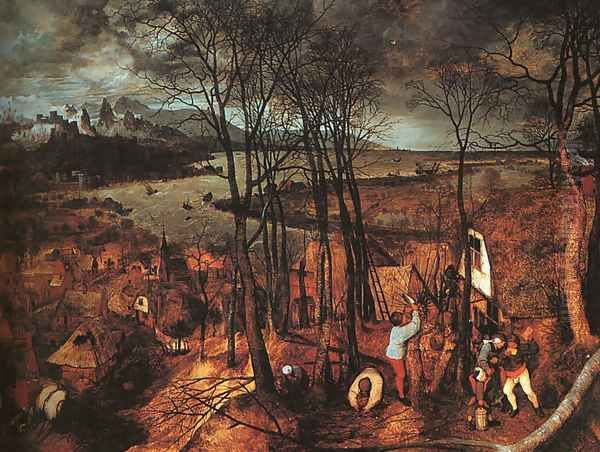
His Italian journey, particularly the experience of the Alps, was crucial. He captured the vastness and structure of mountain ranges with remarkable accuracy in drawings made during his travels. Back in Antwerp, these studies informed his painted landscapes, which often feature a high viewpoint, allowing for panoramic vistas that unfold across plains, rivers, and distant mountains. He masterfully rendered atmospheric perspective, using subtle shifts in color and detail to create a convincing sense of depth and space.
Bruegel's landscapes are rarely just topographical records; they often explore the relationship between humanity and the natural world. His famous series depicting the Months or Seasons, commissioned by the Antwerp merchant Niclaes Jongelinck, exemplifies this. Only five panels survive, including the iconic Hunters in the Snow (representing December/January), The Gloomy Day (February/March), Haymaking (June/July), The Harvesters (August/September), and The Return of the Herd (October/November). These works depict the cycle of the year, showing peasants engaged in activities appropriate to the season, dwarfed by the expansive, sometimes harsh, sometimes nurturing, natural environment.
Chronicler of Peasant Life
Bruegel earned the nickname "Peasant Bruegel" (though sometimes used disparagingly by classicist critics later) for his frequent and vivid depictions of rural life. He moved beyond the often stereotypical or purely comical representations of peasants common in earlier art, offering instead detailed and energetic portrayals of their work, celebrations, and daily existence. His scenes of village fairs, weddings, dances, and games are teeming with life and incident.
Works like Peasant Wedding (c. 1567) and Peasant Dance (c. 1567) are prime examples. Peasant Wedding shows a bustling feast in a barn, filled with individualized figures eating, drinking, serving food (note the famous detail of the two men carrying pies on an unhinged door), and playing music. The composition is dynamic, drawing the viewer into the heart of the celebration. Peasant Dance captures the boisterous energy of a village kermesse (festival), with figures engaged in lively, almost unrestrained, dancing and revelry.
While these scenes possess a documentary quality, offering valuable insights into 16th-century folk customs, they are not simple celebrations of rustic simplicity. Bruegel often includes elements of satire or moral commentary. The peasants' activities can sometimes verge on gluttony, drunkenness, or lustfulness, reflecting contemporary moral concerns about human weakness and sin, perhaps influenced by the satirical tradition of Sebastian Brant's Ship of Fools or the works of Erasmus. However, Bruegel's tone is often ambiguous – sometimes critical, sometimes humorous, sometimes seemingly objective or even empathetic.
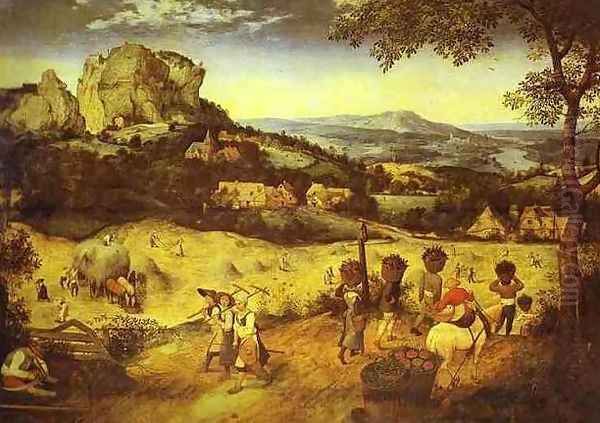
His encyclopedic painting Netherlandish Proverbs (1559) is a tour-de-force in this vein, illustrating over a hundred Dutch proverbs and idioms within a single, densely populated village scene. It presents a "world turned upside down," a catalogue of human folly, absurdity, and vice, rendered with meticulous detail and dark humor. This work, along with others showing children's games or battles between Carnival and Lent, reveals Bruegel's deep interest in observing and cataloguing human behavior in all its variety.
Religious and Allegorical Masterpieces
While renowned for landscapes and peasant scenes, Bruegel also produced powerful religious and allegorical paintings. He approached traditional biblical narratives with the same originality and focus on the human element found in his secular works. Often, the main religious figures are de-emphasized, placed within vast landscapes or amidst crowds of ordinary people, grounding the sacred stories in the contemporary world.
In Landscape with the Fall of Icarus (though the primary version's authenticity is debated, the composition is known through other versions and prints), the dramatic mythological event of Icarus plunging into the sea is relegated to a tiny detail in the corner, unnoticed by the ploughman, shepherd, and fisherman who dominate the scene. This has often been interpreted as a commentary on human indifference to suffering or the insignificance of individual tragedy within the larger cycle of life and nature.
His depictions of the Tower of Babel (he painted at least two versions, the most famous now in Vienna) are monumental explorations of human ambition and hubris. The immense, complex structure, teeming with tiny workers, is set against a vast landscape, emphasizing the scale of the undertaking and its ultimate futility, as described in the biblical story. The meticulous architectural detail likely reflects Bruegel's interest in contemporary engineering as well as ancient Roman structures like the Colosseum, which he would have seen in Italy.
Other works delve into darker allegorical territory, reflecting the turbulent times of religious conflict and the Spanish Habsburg rule in the Netherlands. The Triumph of Death (c. 1562) is a terrifying panoramic vision of destruction, where armies of skeletons wreak havoc upon people from all walks of life, echoing medieval danse macabre themes but with a terrifying, almost modern sense of indiscriminate annihilation. The Fall of the Rebel Angels (1562) and Mad Meg (Dulle Griet) (c. 1563) are chaotic, Bosch-influenced visions filled with grotesque demons and monstrous creatures, likely carrying complex allegorical meanings related to sin, strife, and the political situation.
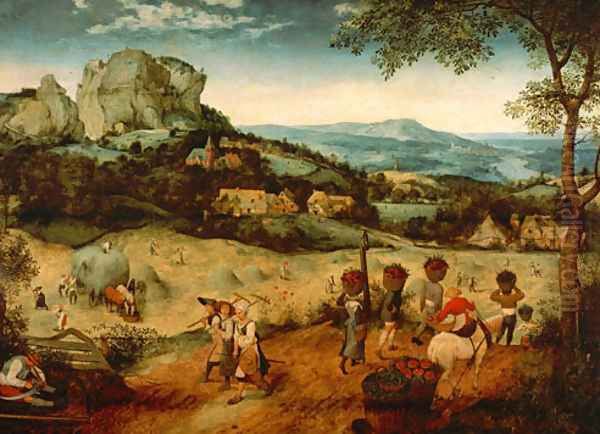
Later works like The Parable of the Blind Leading the Blind (1568) possess a stark, almost brutal realism. Based on the biblical parable (Matthew 15:14), it depicts a line of stumbling blind men, their faces rendered with unflinching detail, inevitably leading each other into a ditch. The painting serves as a powerful metaphor for spiritual or intellectual blindness and the dangers of misguided leadership.
Technique, Composition, and Later Years
Bruegel's technique was rooted in the Netherlandish tradition of oil painting on panel, characterized by meticulous detail, rich colors, and smooth surfaces achieved through layered glazes. However, he adapted this tradition to his own ends. His brushwork could be incredibly fine in rendering details of costume, architecture, or natural elements, but also broader and more expressive where needed, particularly in his later works.
His compositions are often complex and innovative. The use of a high viewpoint in many landscapes and genre scenes allows for a comprehensive overview, packing the scene with information and multiple points of interest. He masterfully organized large numbers of figures into coherent, dynamic groups, guiding the viewer's eye through the narrative or scene. His use of color was both descriptive and expressive, contributing to the mood and atmosphere of the paintings, from the cool blues and whites of Hunters in the Snow to the earthy tones of his peasant scenes.
Around 1563, Bruegel moved from Antwerp to Brussels, possibly to be closer to the court or major patrons, although the exact reasons are unclear. It was in Brussels that he married Mayken Coecke and where his two sons, who would become significant painters themselves, were born: Pieter Brueghel the Younger (1564/65–1638), known primarily for copying his father's works, and Jan Brueghel the Elder (1568–1625), who developed a distinct style specializing in flower paintings and allegorical or mythological scenes, often collaborating with Peter Paul Rubens.
Pieter Bruegel the Elder's career was relatively short; he died in Brussels in 1569, likely still in his early forties. The cause of his death is unknown. Despite the brevity of his mature period (roughly 15 years), his output was substantial and his impact immense.
Legacy and Influence
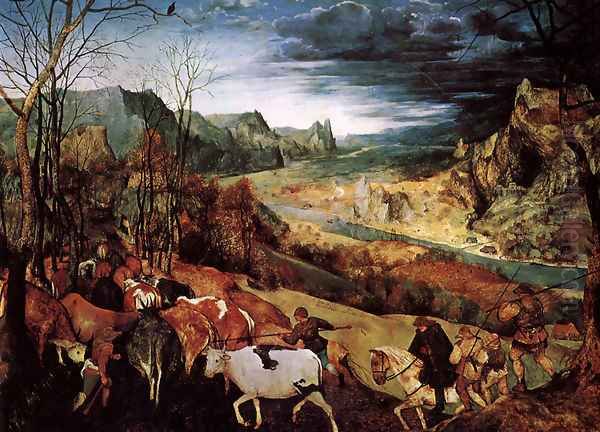
Pieter Bruegel the Elder left an indelible mark on the history of art. His elevation of landscape and genre painting paved the way for the flourishing of these subjects in the Dutch Golden Age during the 17th century. Artists like Esaias van de Velde and Jacob van Ruisdael built upon his innovations in landscape, while genre painters such as Adriaen Brouwer and David Teniers the Younger (who married into the Bruegel family) drew inspiration from his depictions of peasant life.
His sons ensured the continuation of his name and, to some extent, his style. Pieter the Younger's numerous copies and variations of his father's most popular compositions helped to spread Bruegel's imagery widely, cementing his fame. Jan the Elder, while developing his own refined style, inherited his father's meticulous technique and keen observation of nature. His collaborations with Rubens represent a merging of the Bruegelian tradition with the dynamism of the Baroque.
Beyond the Low Countries, Bruegel's work has resonated with artists and viewers across centuries. His ability to combine detailed realism with profound allegory, social commentary with humor, and epic scope with intimate observation gives his paintings enduring relevance. He captured the complexities of the human condition and the beauty and indifference of the natural world in a way that few artists have matched.
Bruegel in the Art Market and Unresolved Questions
Authentic paintings by Pieter Bruegel the Elder are exceptionally rare on the art market. Most of his approximately 40-45 surviving paintings are held in major museum collections, such as the Kunsthistorisches Museum in Vienna (which holds the largest single collection), the Royal Museums of Fine Arts of Belgium in Brussels, and the Museum Boijmans Van Beuningen in Rotterdam.
When works attributed to him do surface, they command significant attention and value. The rediscovery and attribution of The Wine of Saint Martin's Day to Bruegel by the Prado Museum in Madrid in 2010 was a major event. This large-scale work, executed on linen (tüchlein), was subsequently acquired by the Prado, reportedly after being valued at tens of millions of euros, highlighting the immense market value attached to his name. Occasionally, drawings or works whose attribution is debated appear at auction, such as a version of The Painter and the Connoisseur sold in 2024, though prices for works not universally accepted as autograph can vary significantly.
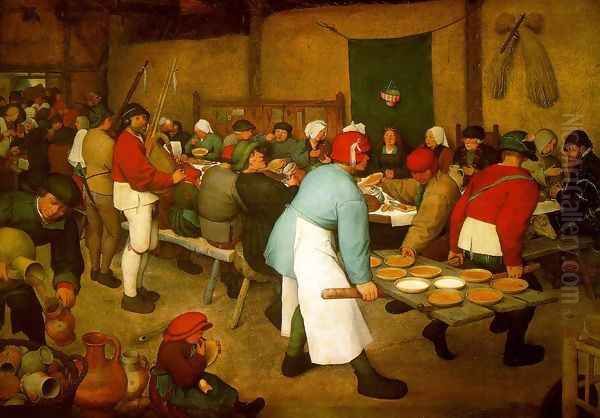
Despite extensive research, questions about Bruegel remain. The exact circumstances of his birth and death, the precise meanings of some of his more complex allegories (like Mad Meg or The Fall of the Rebel Angels), and the full extent of his relationship with patrons and contemporary intellectuals continue to be subjects of scholarly discussion. These ambiguities only add to the mystique of this fascinating artist.
Conclusion: A Unique Vision
Pieter Bruegel the Elder occupies a unique position in art history. He bridged the gap between the late medieval traditions of Northern Europe, particularly the legacy of Bosch, and the emerging humanistic and naturalistic concerns of the Renaissance. He synthesized influences from both North and South, but forged a path distinctly his own. His focus on the lives of ordinary people and the power of the landscape was revolutionary for its time. Through his art, Bruegel explored timeless themes of human nature, society, life, death, and faith with unparalleled visual intelligence, technical skill, and enduring imaginative power, securing his place as one of the true giants of Western art.